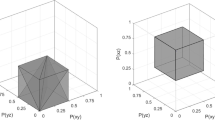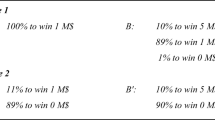Abstract
This paper presents experimental tests of several independence conditions implied by expected utility and alternative models. We perform repeated choice experiments and fit an error model that allows us to discriminate between true violations of independence and those that can be attributed to errors. In order to investigate the role of event splitting effects, we present each choice problem not only in coalesced form (as in many previous studies) but also in split forms. It turns out previously reported violations of independence and splitting effects remain significant even when controlling for errors. However, splitting effects have a substantial influence on tests of independence conditions. When choices are presented in canonical split form, in which probabilities on corresponding probability-consequence ranked branches are equal, violations of the properties tested could be reduced to insignificance or even reversed.




Similar content being viewed by others
References
Abdellaoui, M. (2000). Parameter-free elicitation of utility and probability weighting functions. Management Science, 46, 1497–1512.
Abdellaoui, M. (2009). Rank-dependent utility. In P. Anand, P. K. Pattanaik, & C. Puppe (Eds.), The handbook of rational and social choice (pp. 90–112). Oxford: Oxford University Press.
Abdellaoui, M., Vossmann, F., & Weber, M. (2005). Choice-based elicitation and decomposition of decision weights for gains and losses under uncertainty. Management Science, 51, 1384–1399.
Allais, M. (1953). Le comportement de l’homme rationnel devant le risqué, critique des postulates et axioms de l’ecole americaine. Econometrica, 21, 503–546.
Bateman, I., Munro, A., Rhodes, B., Starmer, C., & Sugden, R. (1997). Does part-whole bias exist? An experimental investigation. Economic Journal, 107, 322–332.
Berg, J. E., Dickhaut, J. W., & Rietz, T. (2010). Preference reversals: The impact of truth-revealing monetary incentives. Games and Economic Behavior, 68, 443–468.
Birnbaum, M. H. (2004). Causes of Allais common consequence paradoxes: An experimental dissection. Journal of Mathematical Psychology, 48, 87–106.
Birnbaum, M. H. (2008). New paradoxes of risky decision making. Psychological Review, 115, 463–501.
Birnbaum, M. H. (2013). True-and-error models violate independence and yet they are testable. Judgment and Decision Making, 8, 717–737.
Birnbaum, M. H., & Bahra, J. P. (2012). Separating response variability from structural inconsistency to test models of risky decision making. Judgment and Decision Making, 7, 402–426.
Birnbaum, M. H., & Navarrete, J. B. (1998). Testing descriptive utility theories: Violations of stochastic dominance and cumulative independence. Journal of Risk and Uncertainty, 17, 17–49.
Birnbaum, M. H., & Schmidt, U. (2015). The impact of learning by thought on violations of independence and coalescing. Decision Analysis. doi:10.1287/deca.2015.0316.
Birnbaum, M. H., & Stegner, S. E. (1979). Source credibility in social judgment: Bias, expertise, and the judge’s point of view. Journal of Personality and Social Psychology, 37, 48–74.
Blavatskyy, P. (2006). Violations of betweenness or random errors? Economics Letters, 91, 34–38.
Blavatskyy, P. (2007). Stochastic expected utility theory. Journal of Risk and Uncertainty, 34, 259–286.
Blavatskyy, P. (2008). Stochastic utility theorem. Journal of Mathematical Economics, 44, 1049–1056.
Blavatskyy, P. (2011). A model of probabilistic choice satisfying first-order stochastic dominance. Management Science, 57, 542–548.
Blavatskyy, P. (2012). Probabilistic choice and stochastic dominance. Economic Theory, 50, 59–83.
Bleichrodt, H., & Pinto, J. L. (2000). A parameter-free elicitation of the probability weighting function in medical decision analysis. Management Science, 46, 1485–1496.
Butler, D. J., & Loomes, G. C. (2007). Imprecision as an account of the preference reversal phenomenon. American Economic Review, 97, 277–297.
Butler, D., & Loomes, G. (2011). Imprecision as an account of violations of independence and betweenness. Journal of Economic Behavior & Organization, 80, 511–522.
Camerer, C. F. (1989). An experimental test of several generalized utility theories. Journal of Risk and Uncertainty, 2, 61–104.
Camerer, C. F., & Ho, T. (1994). Violations of the betweenness axiom and nonlinearity in probability. Journal of Risk and Uncertainty, 8, 167–196.
Conlisk, J. (1989). Three variants on the Allais example. The American Economic Review, 79, 392–407.
Conte, A., Hey, J. D., & Moffatt, P. G. (2011). Mixture models of choice under risk. Journal of Econometrics, 162, 79–88.
Cox, J. C., Sadiraj, V., & Schmidt, U. (2015). Paradoxes and mechanisms for choice under risk. Experimental Economics, 18, 215–250.
Edwards, W. (1954). The theory of decision making. Psychological Bulletin, 51, 380–417.
Gonzalez, R., & Wu, G. (1999). On the form of the probability weighting function. Cognitive Psychology, 38, 129–166.
Green, J. R., & Jullien, B. (1988). Ordinal independence in nonlinear utility theory. Journal of Risk and Uncertainty, 1, 355–387.
Gul, F., & Pesendorfer, W. (2006). Random expected utility. Econometrica, 74, 121–146.
Harless, D., & Camerer, C. F. (1994). The predictive utility of generalized expected utility theories. Econometrica, 62, 1251–1289.
Harrison, G. W., & Rutström, E. (2009). Expected utility and prospect theory: One wedding and a decent funeral. Experimental Economics, 12, 133–158.
Hey, J. D. (1995). Experimental investigations of errors in decision making under risk. European Economic Review, 39, 633–640.
Hey, J. D., & Orme, C. (1994). Investigating generalizations of expected utility theory using experimental data. Econometrica, 62, 1291–1326.
Hey, J. D., Morone, A., & Schmidt, U. (2009). Noise and bias in eliciting preferences. Journal of Risk and Uncertainty, 39, 213–235.
Humphrey, S. J. (1995). Regret aversion or event-splitting effects? More evidence under risk and uncertainty. Journal of Risk and Uncertainty, 11, 263–274.
Humphrey, S. J. (2001). Non-transitive choice: Event-splitting effects or framing effects? Economica, 68, 77–96.
Humphrey, S. J. (2006). Does learning diminish violations of independence, coalescing, and monotonicity? Theory and Decision, 61, 93–128.
Karmarkar, U. S. (1979). Subjectively weighted utility and the Allais paradox. Organizational Behavior and Human Performance, 24, 67–72.
Kilka, M., & Weber, M. (2001). What determines the shape of the probability weighting function under uncertainty. Management Science, 47, 1712–1726.
Loomes, G. (2005). Modelling the stochastic component of behaviour in experiments: Some issues for the interpretation of data. Experimental Economics, 8, 301–323.
Luce, R. D. (1991). Rank- and sign-dependent linear utility models for binary gambles. Journal of Economic Theory, 53, 75–100.
Luce, R. D. (2000). Utility of gains and losses: Measurement-theoretic and experimental approaches. Mahwah: Lawrence Erlbaum Asccociation.
Luce, R. D., & Fishburn, P. C. (1991). Rank- and sign-dependent linear utility models for finite first-order gambles. Journal of Risk and Uncertainty, 4, 29–59.
Luce, R. D., & Marley, A. A. J. (2005). Ranked additive utility representations of gambles: Old and new axiomatizations. Journal of Risk and Uncertainty, 30, 21–62.
Luce, R. D., Ng, C. T., Marley, A. A. J., & Aczél, J. (2008a). Utility of gambling I: Entropy-modified linear weighted utility. Economic Theory, 36, 1–33.
Luce, R. D., Ng, C. T., Marley, A. A. J., & Aczél, J. (2008b). Utility of gambling II: Risk, paradoxes, and data. Economic Theory, 36, 165–187.
Marley, A. A. J., & Luce, R. D. (2001). Ranked-weighted utilities and qualitative convolution. Journal of Risk and Uncertainty, 23, 135–163.
McDonald, J. (2009). Handbook of Biological Statistics. Baltimore: Sparky House Publishing (2nd edition).
Özdemir, T., & Eyduran, E. (2005). Comparison of Chi-Square and likelihood ratio Chi-Square tests: Power of test. Journal of Applied Sciences Research, 1, 242–244.
Quiggin, J. (1981). Risk perception and risk aversion among Australian farmers. Australian Journal of Agricultural Economics, 25, 160–169.
Quiggin, J. (1982). A theory of anticipated utility. Journal of Economic Behavior and Organization, 3, 323–343.
Savage, L. J. (1954). The foundations of statistics. New York: Wiley.
Schmidt, U. (2004). Alternatives to expected utility: Formal theories. In S. Barberà, P. J. Hammond, & C. Seidl (Eds.), Handbook of utility theory, Vol II: Extensions (pp. 757–838). Dordrecht: Kluwer Academic Publishers.
Schmidt, U., & Hey, J. D. (2004). Are preference reversals errors? An experimental investigation. Journal of Risk and Uncertainty, 29, 207–218.
Schmidt, U., & Neugebauer, T. (2007). Testing expected utility in the presence of errors. Economic Journal, 117, 470–485.
Schmidt, U., & Seidl, C. (2014). Reconsidering the common ratio effect: The roles of compound independence, reduction, and coalescing. Kiel working paper no. 1930.
Sonsino, D., Ben-Zion, U., & Mador, G. (2002). The complexity effects on choice with uncertainty – Experimental evidence. The Economic Journal, 112, 936–965.
Sopher, B., & Gigliotti, G. (1993). Intransitive cycles: Rational choice or random errors? An answer based on estimation of error rates with experimental data. Theory and Decision, 35, 311–336.
Starmer, C. (1992). Testing new theories of choice under uncertainty using the common consequence effect. The Review of Economic Studies, 59, 813–830.
Starmer, C. (2000). Developments in non-expected utility theory: The hunt for a descriptive theory of choice under risk. Journal of Economic Literature, 38, 332–382.
Starmer, C., & Sugden, R. (1989). Violations of the independence axiom in common ratio problems: An experimental test of some competing hypotheses. Annals of Operations Research, 19, 79–102.
Starmer, C., & Sugden, R. (1993). Testing for juxtaposition and event-splitting effects. Journal of Risk and Uncertainty, 6, 235–254.
Sugden, R. (2004). Alternatives to expected utility: Foundations. In S. Barberà, P. J. Hammond, & C. Seidl (Eds.), Handbook of utility theory, Vol II: Extensions (pp. 685–755). Dordrecht: Kluwer Academic Publishers.
Tversky, A., & Fox, C. R. (1995). Ambiguity aversion and comparative ignorance. The Quarterly Journal of Economics, 110, 585–603.
Tversky, A., & Kahneman, D. (1992). Advances in prospect theory: Cumulative representation of uncertainty. Journal of Risk and Uncertainty, 5, 297–323.
Viscusi, W. K. (1989). Prospective reference theory: Toward an explanation of the paradoxes. Journal of Risk and Uncertainty, 2, 235–264.
Wakker, P., & Tversky, A. (1993). An axiomatization of cumulative prospect theory. Journal of Risk and Uncertainty, 7, 147–175.
Wakker, P., Erev, I., & Weber, E. (1994). Comonotonic independence: The critical test between classical and rank-dependent utility theories. Journal of Risk and Uncertainty, 9, 195–230.
Weber, M., Eisenführ, F., & von Winterfeldt, D. (1988). The effect of splitting attributes in multiattribute utility measurement. Management Science, 34, 431–445.
Wilcox, N. T. (2008). Stochastic models for binary discrete choice under risk: A critical primer and econometric comparison. Research in Experimental Economics, 12, 197–292.
Wilcox, N. T. (2011). ‘Stochastically more risk averse’: A contextual theory of stochastic discrete choice under risk. Journal of Econometrics, 162, 89–104.
Wu, G. (1994). An empirical test of ordinal independence. Journal of Risk and Uncertainty, 9, 39–60.
Wu, G., & Gonzalez, R. (1996). Curvature of the probability weighting function. Management Science, 42, 1676–1690.
Acknowledgements
We thank Glenn W. Harrison, James C. Cox, Graham Loomes, Peter P. Wakker, Stefan Trautmann, and seminar participants in Tilburg, Orlando, Atlanta, Exeter, Barcelona, Utrecht, and Rotterdam for helpful comments. Thanks are due to Jeffrey P. Bahra for assistance in data collection for Experiment 2.
Author information
Authors and Affiliations
Corresponding authors
Electronic supplementary material
ESM 1
(PDF 861 kb)
Rights and permissions
About this article
Cite this article
Birnbaum, M.H., Schmidt, U. & Schneider, M.D. Testing independence conditions in the presence of errors and splitting effects. J Risk Uncertain 54, 61–85 (2017). https://doi.org/10.1007/s11166-017-9251-5
Published:
Issue Date:
DOI: https://doi.org/10.1007/s11166-017-9251-5
Keywords
- Coalescing
- Errors
- Expected utility
- Independence axiom
- Prospect theory
- Risky decision making
- Splitting effects




